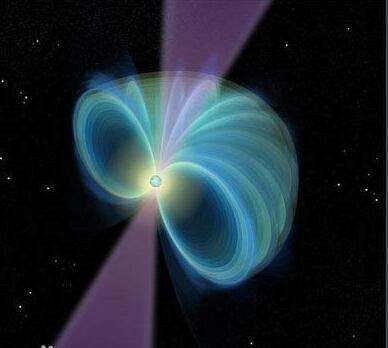In 1967, S. Jocelyn Bell Burnell was a graduate student at Cambridge University.
1967年,约瑟琳·贝尔·伯奈尔从剑桥大学毕业。
She and her thesis advisor, Anthony Hewish, were using a custom-built radio telescope to study radio signals from outer space.
她和自己的论文导师安东尼·休伊什用定制的电波望远镜来研究外太空的无线电讯号。
To their surprise, they saw a series of blips coming from a specific point in the sky.
让他们惊讶的是:他们看到天空里的某一处发出了一系列光点。

It looked like a star -- but it was blinking.
看起来像恒星——但会一直闪烁。
The blinks came like clockwork, every 1.34 seconds.
这种闪烁的方式就像上了发条一样,每1.34秒闪烁一次。
It was so regular that it seemed like it couldn’t be a natural signal.
其闪烁非常有规律,所以看起来不可能是自然信号。
At first, they thought they might have detected a beacon of some kind … an alien beacon.
起初,他们以为可能是发现了灯塔一类的东西,比如外星灯塔。
What they’d found wasn’t aliens, but it was just as strange: a star, denser than liquid mercury, revolving completely in just over a second, and made of a material totally unlike anything you’d find on Earth.
他们发现的并不是外星人,但其怪异程度不亚于外星人:它是一颗恒星,密度比液态水银大,只需一秒多的时间就能旋转一圈,其组成成分是地球上找不到的。
Radio telescopes like the one Burnell and Hewish were using can be very sensitive to outside interference.
电波望远镜,比如伯奈尔和休伊什用的那种,对外界的干扰非常敏感。
With all the AM and FM broadcasts around, they first had to eliminate any Earthly source for the mysterious blinks.
太空里有太多的调幅和调频,所以,这种神秘的闪烁现象首先是跟地球上的干扰无关了。
But it was clear the signal was coming from outer space.
显然,信号是来自外太空的。
As a joke, Burnell and Hewish called the signal “LGM-1”, for Little Green Men.
伯奈尔和休伊什笑称它为“小绿人”(LGM-1)。
They knew it was unlikely that the signal was actually coming from an alien civilization, but they didn’t want to publish their discovery until they had a better idea of what it was.
他们也知道这个信号不可能来自外星文化,但他们想了解清楚之后再发表自己的发现成果。
The last thing they wanted was to announce that they’d found extraterrestrial life, only to have it turn out they that were wrong.
他们最不想看到的情况是:自己对外宣称发现了天外来客,但最后却发现自己是错的。
Then they found a second set of blips, which made it pretty clear that this wasn’t something artificial.
随后,他们又发现了一组闪烁的信号,这让一切变得颇为明显:这种信号并非人工制造的。
Because what were the odds that two sets of little green men happened to be pointing their beacons at planet Earth?
因为怎么会这么巧有两组小绿人将灯塔对着地球呢?
What they’d found was a pulsing star, or pulsar, specifically PSR B1919+21.
他们发现的是脉冲星,代号为PSR B1919+21。
The catchy name comes from its celestial coordinates.
这个与众不同的名字是根据其天球坐标命名的。
But it was another astronomer, Thomas Gold, who first proposed that pulsars are neutron stars.
但却是天文学家汤马士·戈尔德率先提出这些脉冲星其实是中子星的。
A neutron star is formed when a very, very massive star — at least eight times the size of our Sun — explodes in a supernova at the end of its life.
中子星形成的条件是:超大质量的恒星——质量至少是太阳的8倍——在生命快要终结的超新星阶段发生爆炸,
All that’s left is the star’s iron core.
而只留下了铁芯。
Gravity wants to pull the core into a smaller sphere.
重力的作用有将这个铁芯压缩为更小球体的倾向。
It pulls so hard, it starts to affect the atoms in the core itself.
由于压缩的力度很大,所以会影响到铁芯中的原子。
The electrons in the core are actually squeezed into the nuclei of their atoms, where they combine with protons to form neutrons.
实际上,铁芯中的电子被挤压到了原子核中,然后与质子结合形成了中子。
Neutrons actually make up almost all the matter in the stellar core — that’s why it’s called a neutron star.
恒星核心的大部分物质几乎都是由中子组成的——中子星也是得名于此。
And this strange form of matter is unbelievably dense.
而中子星的物质组成形式是非常奇特的——密度极高。
A neutron star might have 1-3 times our Sun’s mass, all smashed into a sphere just a few kilometers in diameter.
中子星的质量可能是太阳的1-3倍,由于被挤压成了球体,所以直径只有几千米。
Astronomers Walter Baade [BAH-day] and Fritz Zwicky first predicted neutron stars existed in the 1930s.
天文学家沃尔特·巴德和弗里茨·兹威基最先预测有中子星的存在是在上世纪30年代。
But no one had ever observed any kind of neutron star until Burnell and Hewish found their pulsar almost 40 years later.
但他们预测后,一直没有人观测到过中子星的存在,直到伯奈尔和休伊什在近40年后发现了脉冲星。
So where do a pulsar’s pulses come from?
那么脉冲星的脉冲从何而来呢?
Pulsars have extremely powerful magnetic fields.
脉冲星的磁场极强。
This makes them emit beams of electromagnetic radiation, often in the form of radio waves, from their magnetic poles.
这就使得他们的两个磁极发射出电磁辐射,这种电磁辐射通常以无线电波的形式存在。
What we see as pulses are the beams of radiation sweeping across Earth as the neutron star spins, like the beams of a lighthouse.
我们所说的脉冲是指中子星旋转时发射到地球上的辐射束,就好像灯塔发出的光一样。
And they’re spinning faster than you might expect.
其转速比我们能想象到的都要快。
Normally, adult stars do rotate — but at a nice, leisurely pace.
正常情况下,成年恒星都会旋转,而且是以泰然自若的方式进行。
As a star’s core collapses after a supernova, though, it starts to spin much faster.
超新星阶段后,恒星的内核开始分崩离析,而转速会变得更快。
It’s like an ice skater.
就像滑冰一样:
As she pulls her arms in closer to her body, she spins faster.
手臂离身体越近的时候,转速就越快。
The same thing happens with a neutron star.
中子星的情况与此同理:
As it shrinks, the core spins faster.
越收缩,内核转速就越快。
And because neutron stars are so small, they can end up spinning really quickly.
而由于中子星体积太小了,所以最后的转速会非常快。
The fastest pulsar we’ve ever found is spinning 716 times per second!
我们发现的转速最快的脉冲星可达到716次/秒的转速。
Astronomers think the pulsars with the fastest spins, called millisecond pulsars because their spins can be measured in milliseconds, started their lives in binary pairs, pairs of stars orbiting each other.
这种转速极高的脉冲星也叫毫秒脉冲星(因为转速周期可以用毫秒来计)。天文学家认为,毫秒脉冲星最开始是双子星的形式。
After the pulsar’s core collapses, its super strong gravitational pull sucks down material from the surface of its companion star.
毫秒脉冲星的内核分崩离析后,其极强的引力作用就会从伴星表面吸引很多物质。
As the neutron star’s mass increases, the star spins even faster.
随着中子星质量的增大,其转速也越来越快。
These whirling bodies are sometimes called recycled pulsars, since they re-use material from other stars.
人们有时候也会将这种旋转的星体称为再生脉冲星,因为再生脉冲星会再次利用来自其他恒星的物质。
Because a pulsar’s rotation is so fast and so regular, any changes to it are really significant.
由于脉冲星转速极高,而且非常规律,所以任何改变的影响都会非常大。
The first exoplanets ever discovered were actually orbiting a pulsar.
人类首次发现的外星行星当时是在围绕脉冲星旋转的。
They were found because the planets’ gravity affected the pulsar’s motion, causing changes in the pattern of pulses.
之所以能发现它们,是因为外星行星影响了脉冲星的转动,引起了脉冲模式的改变。
But what’s probably the strangest pulsar is part of the only binary pulsar system we’ve ever discovered.
但最怪异的脉冲星要属人类发现的唯一一个双子脉冲星系统的部分区域了——
That’s two pulsars orbiting each other.
两颗互相围绕的脉冲星。
The smaller of the two pulsars is the weird one: it doesn’t seem to have exploded in an enormous supernova, like a regular neutron star.
两颗脉冲星中较小的那个比较怪异:这颗脉冲星看起来不像在大型超新星中爆炸过的,跟正常的中子星不太像。
It had already lost a lot of its mass to its companion, which became a pulsar first.
这颗脉冲星中的很多质量都被伴星吸走了,所以伴星先成了脉冲星。
Astronomers think it must have exploded at some point, but in an explosion that was smaller than a supernova.
天文学家人为,这颗脉冲星一定在某个时候发生了爆炸,只不过爆炸的规模不如超新星那样大。
So they’re not quite sure the star was like before it became a pulsar or how exactly it turned into one.
所以他们不太确定这颗恒星在成为脉冲星之前的样子以及其转变为脉冲星的过程。
It’s just one more unexplained pulsing signal teasing astronomers.
这颗恒星规律闪烁的未解之谜依然让天文学家为之着迷。
Thank you for watching this episode of SciShow Space, and especially to all our patrons on Patreon.
感谢收看本期的《太空科学秀》,尤其要感谢我们节目的忠实粉丝。
If you’d like to make videos like this possible, just go to Patreon dot com slash SciShow.
如果大家想助力节目视频的制作,可以登录Patreon.com/SciShow。
And don’t forget to go to YouTube.com/SciShow Space and subscribe!
记得订阅YouTube.com/SciShow Space哦!











